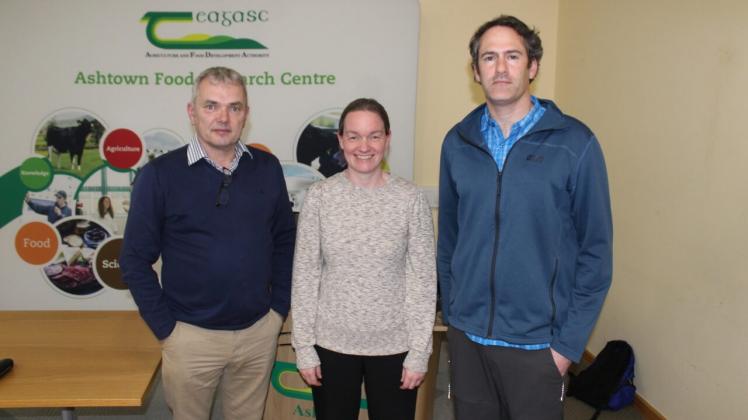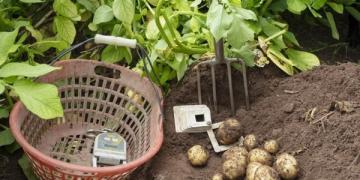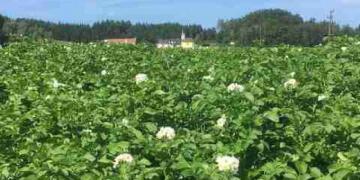Irlanda: Potato industry entering new era of blight management
The Irish potato industry looks set to enter a new era of blight management as it approaches the 2024 growing season.

It is a future based on the set of two active fungicide molecules in combination – and each at full rate – each time a crop is sprayed for blight.
Driving all of this, is the confirmation that blight populations are fast developing resistance to the fungicide chemistries currently available at an ever increasing rate.
More specifically, last autumn was marked by the confirmation that the EU43 variant of the blight fungus (phytophthora infestans) had been identified in Irish potato crop samples.
This is the genotype that had previously caused damage to potato crops in both Denmark and the Netherlands, as a direct result of its resistance to the carboxylic acid amide (CAA) group of fungicides.
Despite the fact that only one EU43 infected sample was identified, Teagasc and all other stakeholder groups within the potato sector are now working on the basis that the genotype is on the island of Ireland and poses a major threat to Irish potato crops that are grown this year.
The envisaged response at grower level will be the ramping up of all blight spray formulations, both in terms of their scope and complexity.
Potato blight
By taking this approach, Teagasc potato specialists believe that the threat of EU43 can be controlled.
However, the steps required to make this happen at farm level will, probably, double the cost of the associated blight prevention programmes that will be required.
Teagasc hosted a specific blight workshop for representative all relevant potato stakeholders groups recently.
The event was the first in a series of events that will be held over the coming weeks with a clear focus on the threat posed by the EU43 genotype.
Attending the Teagasc blight workshop (l-r): Tim Reed, Teagasc Oak Park; Tom Loughran, Co. Meath; Stephen McCabe, Haggard Stores, Co. Dublin
This specific blight variant was first identified in Denmark back in 2018. However, it was the carnage caused by the new genotype within Dutch potato populations last year that has raised the alarm bells regarding its potency and the potential damage it can cause to the Irish potato industry, if suitable preventative measures are not taken.
Attendees at the workshop were told it normally takes two years after new blight genotypes have been identified in the UK or mainland Europe to get to Ireland.
Imported seed potatoes constitute a key disease vector in this regard.
The Dutch experience
Dutch plant pathologist, Dr. Geert Kessel, from Wageningen University addressed the Teagasc workshop.
He confirmed that the potato blight fungus is now completing its life cycle in a much shorter period of time than would have previously been the case.
He added: “20 years ago, it would have taken the fungus five to 10 days to complete its various growth and reproductive phases. Today we are talking two to five days.
“The potential for phytophthora infestans to mutate is immense. 1ha of infected potatoes can produce four times 10 to the power of 12, sporangia. These are containers within which spores can form.
“Research has confirmed that 40,000 of these sporangia will contain mutated genetic material.”
According to Kessel, the Dutch potato industry totally underestimated the potential impact of the EU43 blight genotype last year.
This was despite the fact that previous experience in Denmark has confirmed the significant increase of its prevalence within that country’s blight populations.
In 2018, EU43 accounted for just 2% of the blight variants identified in Denmark. By 2022 that figure had risen to 43%.
Weather factors in 2023
Dr. Kessel continued: “Last year’s very challenging weather conditions also combined to enhance the impact of the EU43 genotype.
“Main crop potatoes were planted out in late May. While daytime conditions were dry and quite warm at that stage, crops experienced quite a dramatic drop in temperatures during the night-time hours.
“This facilitated early blight infections. But as the season progressed, the heavy rains arrived, impacting on potato crop performance right through to harvest,” he added.
Blight Met Éireann
According to Kessel, the fundamental mistake made by Dutch potato growers last year was to use blight control applications that focused on the use of a single fungicide molecule.
He explained: “This gave the genotype an opportunity to develop almost unhindered. We now know from the experience gained in Denmark that the most effective way of countering EU43 is to use a combination of fungicide molecules at full rate throughout the growing season.”
According to Kessel there is now evidence pointing to EU43’s resistance to other blight chemistries.
“This is extremely worrying as is the identification of another blight genotype – EU46.”
ADAS trials
ADAS plant pathologist, Dr. Faye Ritchie, also addressed the blight workshop. She highlighted the growing threat of new blight genotypes and the steps growers can take to prevent their impact on potato crops, making use of the existing blight chemistries.
According to the ADAS representative, this will entail widest use of the various blight chemistries – in approved combinations – throughout the growing season.
“We now know that using the same chemistry throughout the lifespan of a crop is the most effective way of encouraging resistance within an ambient blight population,” Dr. Ritchie said.
Teagasc recommendations 2024
Teagasc’s Dr. Steven Kildea told the workshop that an holistic approach must be taken regarding the management of fungicide resistant blight genotypes.
His research work focuses on the development of sustainable disease control strategies for Irish arable and potato crops.
Kildea commented: “The further development of blight resistant potato varieties will be part of this process moving forward.
“Growers will also be required to implement crop management strategies that minimise the potential for blight variants to become established in crops.
“This will include the use of seed that is pathogen-free and the effective management of potato volunteers.”
He explained that there is also a need to develop fungicide spray strategies that do two things – prevent blight becoming established within crops while, at the same time, controlling the exposure of existing fungicide chemistries to new blight variants.
Attending the blight workshop (l-r): CAFRE’s Robin Bolton and Leigh McClean
Kildea stressed the fast evolving nature of blight resistance.
He further explained: “Using combinations of different blight control chemistries throughout the growing season is the future for potato growers.
“But this blight management approach will entail a significantly increased cost, where the future procurement of blight sprays is concerned.”
Kildea discussed a possible blight prevention spray programme that might be considered by Irish potato growers this year, based on a projected 15-phase cycle.
According to Kildea, the work carried out to date has identified 14 of the 15 envisaged spray cycles.
“The threat of fungicide-resistant blight genotypes will rise in significance during the period ahead,” he said.
“And the potato industry must respond in a multi-faceted manner. However, the short-term imported seed from countries, such as the Netherlands, will heighten the challenge posed by the EU43 blight genotype in 2024.”
Fuente: https://www.agriland.ie/farming-news/potato-industry-entering-new-era-of-blight-management/








